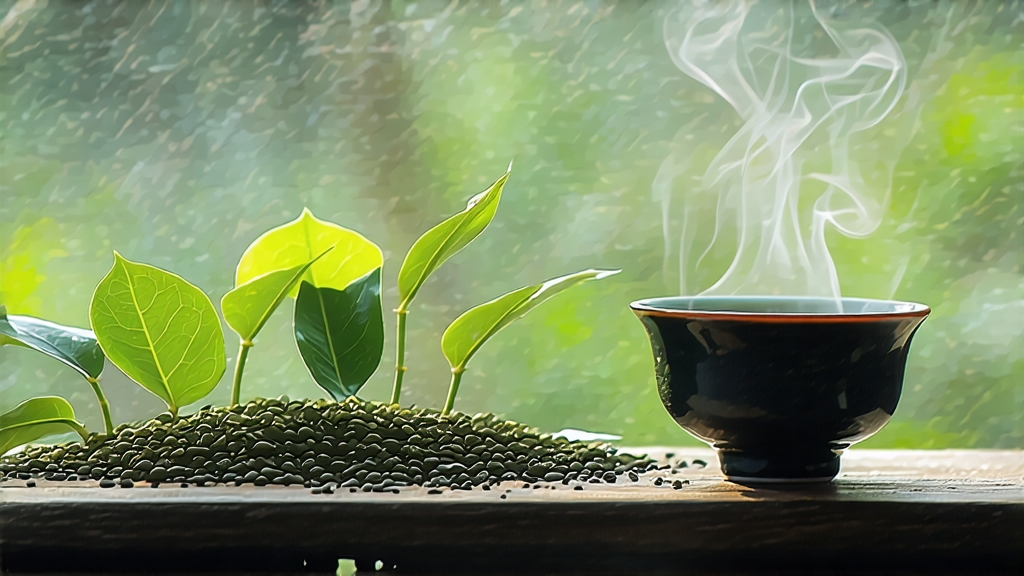
Alishan High-Mountain Oolong, known in Taiwan as “Alishan Qing Xiang Oolong,” is the island’s most celebrated gift to the world of tea. Grown between 1,000 and 1,400 meters on the forested spine of the Alishan range, this cultivar captures the essence of subtropical clouds, alpine soil, and centuries-old craft. To understand it is to travel through geology, history, and the quiet choreography of leaf, water, and breath.
History and Terroir
Tea plants first ascended Alishan in the late 19th century when the Qing government encouraged Han settlers to replace mountain rice with higher-value crops. The arrival of the Qingxin (Green Heart) cultivar in 1896, grafted from Wuyi cuttings, marked the birth of a new style. At altitude, cooler nights slow leaf growth, thickening cell walls and concentrating amino acids. Morning fog acts as a natural shade cloth, prompting the plant to generate more chlorophyll and fragrant volatiles. Volcanic tuff and decomposed granite soil, rich in iron and micro-elements, lend a subtle mineral spine that distinguishes Alishan from lower-elevation Taiwanese oolongs. By the 1980s, government-sponsored competitions elevated Alishan to cult status; today, top lots fetch prices rivaling Burgundy grand crus.
Cultivar and Harvest Calendar
Almost all authentic Alishan Oolong is made from Qingxin (Camellia sinensis var. sinensis cv. Qingxin). This bush is temperamental—sensitive to frost yet incapable of producing compelling tea below 800 m. Spring plucking begins when night temperatures stabilize above 10 °C, usually between late March and mid-April. A lighter autumn harvest follows in October, yielding a more floral but less creamy cup. Winter harvests, though rare, can be ethereal when sudden cold fronts lock aromatics inside the leaf. Only the apical two leaves and a bud are taken, ideally before 10 a.m. while dew still glistens, ensuring optimal moisture balance for the long withering ahead.
Craft: The Alpine Oxidation Dance
Within minutes of plucking, the leaves are conveyed to the mountain-top factory, a cedar-clad building that hums with bamboo drums and the soft clatter of cloth-lined baskets. The goal is 20–30 % oxidation—less than Dong Ding, more than green tea—preserving a bright jade infusion while developing honeyed complexity.
- Outdoor Withering: Leaves are spread 3 cm thick on rattan trays set outside in dappled shade. Cool alpine air lowers leaf temperature, so withering lasts 60–90 minutes instead of the 30 typical in lowlands. Masters “wake” the leaf every 15 minutes, tossing it skyward so edges bruise lightly, initiating oxidation.
- Indoor Withering: Trays move indoors where 22 °C air and 75 % humidity allow a slower, even oxidation. The leaf loses 8–10 % moisture and emits a faint lily aroma; this is the signal to begin shaqing (kill-green).
- Kill-Green: A 260 °C drum roaster halts oxidation in 3–4 minutes. The brief heat sets the greenish-gold color and locks in floral notes.
- Rolling: While still warm, leaves are wrapped in cotton cloth and rolled in a mechanical press that applies 30 kg of pressure for 3 minutes, followed by 2 minutes of release. This cycle repeats 30–35 times, shaping the leaf into the characteristic hemispherical “dragon ball.”
- Drying: Low-temperature ovens (80 °C) reduce moisture to 3 %, stabilizing the leaf for months of alpine transport.
- Fluffing & Sorting: A final hand-picking removes stems and yellow leaves; the finished tea rests for 48 hours so residual heat and moisture equilibrate.
Flavor Lexicon
Dry leaf aroma: fresh cream, alpine orchid, and a whisper of starfruit.
First infusion: pale jade liquor, viscosity like 2 % milk, top notes of gardenia and snap pea.
Second infusion: a sweeter, custard body emerges, reminiscent of Taiwanese papaya with a talc-like minerality on the finish.
Third infusion: a cool menthol sensation appears—what locals call “high-mountain qi”—lingering in the throat for minutes.
Used leaves: when unfurled under water, they reveal complete, serrated blades the size of a